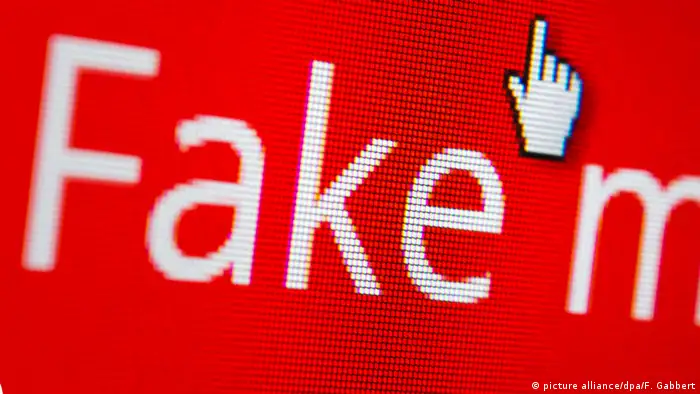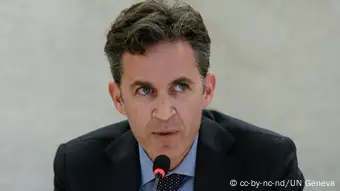Insights
Countering fake news while safeguarding free speech
As fighting fake news becomes a global priority, questions remain about what exactly fake news is, what can be done to stop it and how to do so without curbing free speech.
There's nothing fundamentally new about fake news. It swept through Europe with the invention of the printing press in 1439, which allowed for the rapid circulation of false information.
Now fake news is having a second heyday – assisted this time by the spread of social media which has fundamentally changed the news ecosystem and created a favorable climate for the bogus news boom.
Disinformation and fake news played (and still plays) a crucial role in the Russia-Ukraine conflict, and Russia's use of false stories as a cyberwarfare tactic is a real threat in countries as diverse as Sweden, Estonia and Moldova. In the Global South, fake news has lead to xenophobia attacks and violence. Fake news potentially affected the outcome of the US presidential elections and it's feared it could also influence key elections in France, the Netherlands and Germany in 2017.
The proliferation of fictitious stories isn't just motivated by propaganda, though, but also by profit. Hoax news websites have tapped into the deficiencies of social media algorithms to turn fake news into a big business.
But what is exactly fake news? How does it affect democracy and public discourse? And importantly, what can be done to counter its effects?
Propaganda, bias and sloppy reporting
The challenge of fake news starts with its definition; it can mean very different things depending on who is speaking and what the context is.
Fictional news deliberately designed to deceive readers is obviously fake news. But what about news written with a specific slant for a specific audience, such as the content on hyperpartisan websites and their associated Facebook pages, stories that frequently demonize the other side's point of view, often at the expense of facts?
And what about erroneous or unverified information that doesn't necessarily intend to deceive but is false all the same? The dizzy speed of the digital news cycle means even traditional media outlets pay less attention to verifying facts and sources. Because social media can spread this information in the blink of an eye, sloppy journalism can have an enormous impact. But is it fake news?
Are satire, hoaxes and jokes fake news, too? Satire can be subtle enough to trick even news-savvy readers. The farcical newspaper "The Onion" is often mistaken for real news.
Another problem besetting fake news is that the term has been hijacked to denounce unfavorable reporting. As an extreme example, US President Donald Trump often blasts mainstream outlets such as the New York Times as "fake news media", causing the Washington Post (another Trump target) to declare that fake news has "lost all meaning".
"News stories that have no factual basis but are presented as facts" is one possible definition used in a January 2017 study of fake news by Stanford University. Their definition excludes false statements made by politicians (because that's not news but rather a political statement) as well as satirical content (PDF).
This definition raises the issue of how to measure the factual basis or truth of a story and who should be responsible for measuring it. In a recent EU debate, representatives from former Soviet bloc countries (where in Soviet times the press was under the strict control of the state) warned of the risks of a single body having a monopoly on the "truth".
"Fake news is a bad thing, but according to my understanding, the Ministry of Truth is also bad," said Estonia's Andrus Ansip, the EU Commissioner for the digital single market, referring to the ministry responsible for the slogans and falsehoods in George Orwell's dystopian novel "1984".
Calculating the impact of fake news
Although fake news is flooding social media, it's difficult to know how many people are actually reading or viewing it and what effect it has.
An analysis by BuzzFeed, a US news site, conducted in November 2016 found that during the final months of the US presidential campaign, fake news stories outperformed real news on social media, drawing more shares and engagement than news content from respected mainstream media. Similarly, a recent Pew Research Center survey suggested that almost a quarter of American adults have shared fake news, knowingly or unknowingly.
On the other hand, a study published by the Columbia Journalism Review in 2017 found the reader base of fake news websites is about 10 times smaller than "real" news sites. It also revealed that people exposed to fake news aren't only necessarily experiencing the Internet in a filter bubble (as is often presumed) but also visit real news sites, and therefore access verified information as well. Very much in line with this research, according to the Stanford University fake news study, is that social media wasn't people's most important source of US election news and that "even the most widely circulated fake news stories were seen by only a small fraction of Americans."
But these findings don't mean we can afford to ignore the potential dangers of fake news, especially in the media ecosystems of countries where social media is the most important source of information.
Research by the Reuters Institute showed that in the vast majority of the 26 countries analyzed, more people now rely on social media than printed newspapers as a source of news. Across the entire sample, 12 percent now consider social media as their main source of news; when looking at under 25-year-olds, this swells to 25 percent. (PDF)
The danger here is that as these younger adults, who are using social media as a primary source, grow older, a whole generation might eventually not be able to differentiate between verified information and fake news. In vulnerable democracies, such as Myanmar, for example, fake news and hate speech can go hand in hand and lead to a vicious circle in which false information is an instrument of hate, and heated emotions can result in more fake reporting.
The risks of overreacting
At the same time, a strictly legal approach to fighting fake news could be dangerous. Attempts to define, regulate and penalize what is seen as "fake news" could lead to violations of the right to freedom of expression. It could well be that tolerating false news stories, rumors and even outright lies are the price to pay for the civil liberties of free communication.
This point was stressed in a joint declaration by prominent international organizations monitoring press freedom. Leading advocates like David Kaye, the UN Special Rapporteur on Freedom of Opinion and Expression, and his colleagues from the African Union, the Organization of American States and the OSCE agreed that a human rights-based approach is essential to fighting propaganda, disinformation and fake news, and that states should refrain from introducing provisions on fake news which violate international human rights standards.
Kaye emphasized that efforts to counter fake news could lead to censorship, the suppression of critical thinking and other approaches contrary to human rights law.
In Egypt, for example, an Al Jazeera reporter arrested in December 2016 is still in jail on fake news charges, and in Ecuador – despite the protests of press freedom organizations – legislation includes a penalty of five to seven years in prison for creating economic panic by "publishing, spreading, or divulging false news that causes harm to the national economy in order to alter the prices of goods".
According to Article 19, a UK non-governmental organization defending freedom of expression, the negative impacts of false news are already partially addressed by existing laws. Further legislation would, rather, have "a chilling effect upon the media", as slight inaccuracies in reporting cannot be avoided.
Leading social media platforms are already developing tools which would penalize false news websites; Facebook recently integrated fact-checking into its publication process and in March, started flagging fake news.
It has also started throttling money to bogus sites that live from the deliberate publication of fake news, as has Google.
Other initiatives are focusing on scaling up verification efforts. The BBC, for instance, is setting up a dedicated fact-checking team to debunk misleading and false stories while First Draft, a non-profit which advises on consuming and producing news, launched a global collaboration of newsrooms, social media platforms and fact-checking initiatives in September 2016 to battle fake news.
International media development organizations can also play an important role by spurring their efforts to improve journalism education, support quality journalism initiatives, fact-checking outlets and self-regulatory mechanisms, or set up extensive media and information literacy programs to help people better navigate the digital realm.
DW recommends
WWW links
- Date 14.03.2017
- Author Attila Mong
- Feedback: Send us your feedback.
- Print Print this page
- Permalink https://p.dw.com/p/2Z7pu
- Date 14.03.2017
- Author Attila Mong
- Send us your feedback.
- Print Print this page
- Permalink https://p.dw.com/p/2Z7pu




